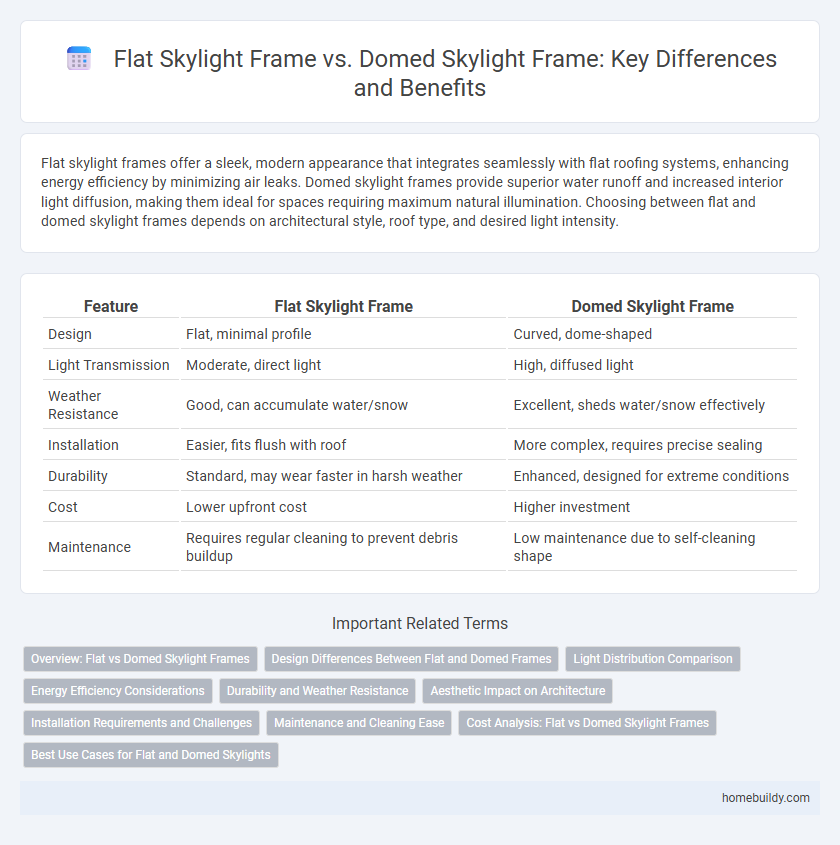Flat skylight frames offer a sleek, modern appearance that integrates seamlessly with flat roofing systems, enhancing energy efficiency by minimizing air leaks. Domed skylight frames provide superior water runoff and increased interior light diffusion, making them ideal for spaces requiring maximum natural illumination. Choosing between flat and domed skylight frames depends on architectural style, roof type, and desired light intensity.
Table of Comparison
| Feature | Flat Skylight Frame | Domed Skylight Frame |
|---|---|---|
| Design | Flat, minimal profile | Curved, dome-shaped |
| Light Transmission | Moderate, direct light | High, diffused light |
| Weather Resistance | Good, can accumulate water/snow | Excellent, sheds water/snow effectively |
| Installation | Easier, fits flush with roof | More complex, requires precise sealing |
| Durability | Standard, may wear faster in harsh weather | Enhanced, designed for extreme conditions |
| Cost | Lower upfront cost | Higher investment |
| Maintenance | Requires regular cleaning to prevent debris buildup | Low maintenance due to self-cleaning shape |
Overview: Flat vs Domed Skylight Frames
Flat skylight frames feature a streamlined, low-profile design that optimizes modern architectural aesthetics and reduces wind resistance. Domed skylight frames boast a curved, raised structure that enhances natural light diffusion and improves water runoff, preventing leaks. Material durability and installation requirements vary, with flat frames often integrating seamlessly into flat roofs, while domed frames suit pitched or irregular rooflines.
Design Differences Between Flat and Domed Frames
Flat skylight frames offer a sleek, modern aesthetic with clean lines that blend seamlessly into contemporary architecture, while domed skylight frames provide a more traditional, curved contour that enhances natural light diffusion. The flat design optimizes panoramic views and maximizes ceiling space, whereas the domed structure improves water runoff and reduces debris accumulation. Material choices also differ, with flat frames often using aluminum or steel for durability and domed frames utilizing acrylic or polycarbonate for impact resistance and UV protection.
Light Distribution Comparison
Flat skylight frames provide a more uniform and direct light distribution, reducing glare and allowing natural light to spread evenly across interior spaces. Domed skylight frames enhance light diffusion by capturing sunlight from multiple angles, increasing brightness and minimizing shadows. Choosing between flat and domed skylight frames depends on desired light intensity and spatial light dynamics in the room.
Energy Efficiency Considerations
Flat skylight frames typically offer better energy efficiency due to their lower profile, which reduces heat loss and gain by minimizing air leakage and improving insulation integration. Domed skylight frames often allow more natural light but can result in higher heat transfer because of their curved surfaces, increasing cooling and heating demands. Choosing between flat and domed frames depends on balancing desired daylight benefits with the thermal performance and climate-specific energy needs of the building.
Durability and Weather Resistance
Flat skylight frames typically offer enhanced durability due to their simpler design and lower profile, which reduces exposure to wind uplift and debris impact. Domed skylight frames provide superior weather resistance by allowing water and snow to easily slide off, preventing accumulation and potential leaks. Both frame types often use materials like aluminum or uPVC with weatherproof coatings to improve longevity and withstand harsh environmental conditions.
Aesthetic Impact on Architecture
Flat skylight frames offer a sleek, modern aesthetic that seamlessly integrates with contemporary architectural designs, providing a minimalist profile and clean lines. In contrast, domed skylight frames create a distinctive, curvilinear silhouette that enhances traditional or eclectic building styles by adding volume and a sculptural element to the roofline. The choice between flat and domed skylight frames significantly influences the visual character and light diffusion, shaping the overall architectural appeal and ambiance.
Installation Requirements and Challenges
Flat skylight frames require precise measurements and level roof surfaces to ensure proper sealing and prevent water leakage, often demanding more careful waterproofing techniques. Domed skylight frames, while more forgiving on uneven roofs, present challenges in securing curved glass or acrylic panels and may require specialized mounting hardware to accommodate their shape. Both types necessitate careful coordination with existing roof structures to maintain integrity and insulation performance during installation.
Maintenance and Cleaning Ease
Flat skylight frames offer easier maintenance and cleaning due to their simple, smooth surfaces that prevent debris buildup and allow easy access for wiping and washing. Domed skylight frames, with their curved design, often accumulate dirt and water along edges and corners, requiring more frequent and detailed cleaning efforts. Flat frames generally reduce the need for specialized tools or professional services, ensuring quicker and more cost-effective upkeep.
Cost Analysis: Flat vs Domed Skylight Frames
Flat skylight frames generally offer a lower initial cost compared to domed skylight frames due to simpler manufacturing and installation processes. Domed skylight frames often incur higher expenses related to materials and labor, but they provide superior water runoff and enhanced durability in harsh weather conditions. When conducting a cost analysis, considering long-term maintenance and potential energy savings is crucial, as flat frames may require more frequent upkeep and seal replacements.
Best Use Cases for Flat and Domed Skylights
Flat skylight frames are ideal for modern architectural designs and low-slope roofs, offering a sleek profile that blends seamlessly with flat or gently inclined surfaces. Domed skylight frames perform best on steeply pitched roofs and areas requiring enhanced water runoff, preventing pooling and reducing leakage risk. Both options improve natural lighting, but flat skylights suit urban settings, while domed skylights excel in regions with heavy rainfall or snow.
Flat skylight frame vs domed skylight frame Infographic

 homebuildy.com
homebuildy.com